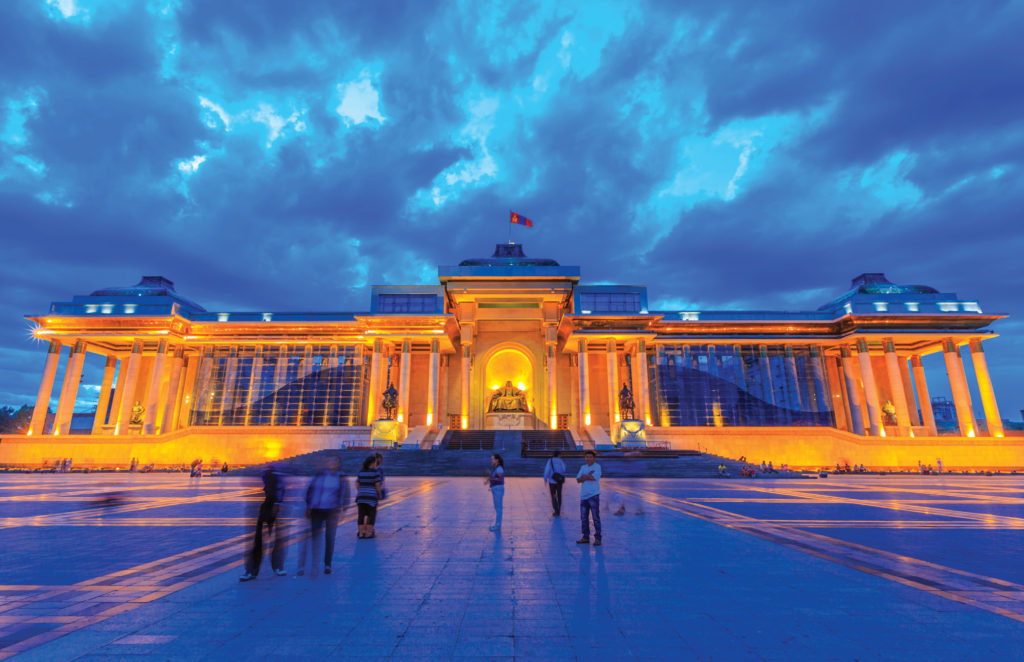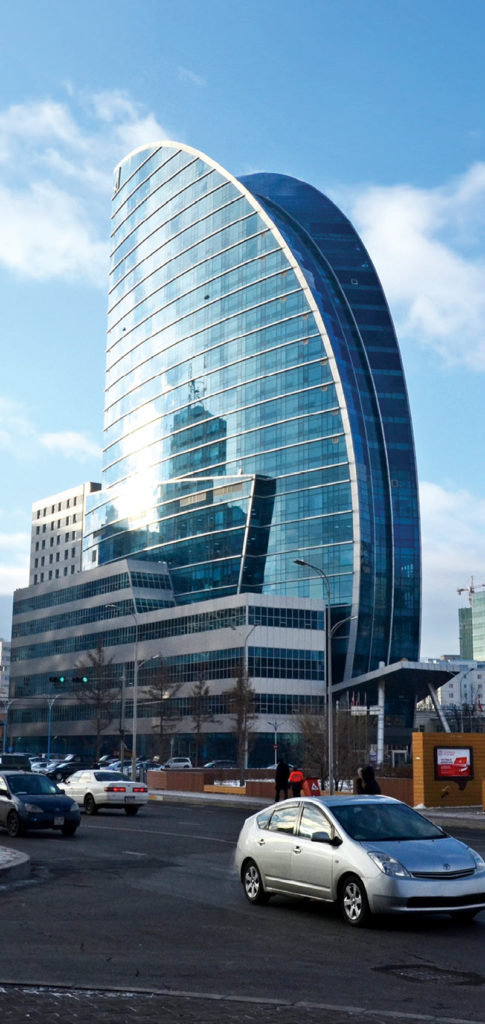 An eleventh-hour deal to plough $4.4 billion into a gargantuan mine in Mongolia may have dragged the country’s hand away from the self-destruct button and placed it firmly on to the steering wheel of an economy that could become the star performer of 2016.
An eleventh-hour deal to plough $4.4 billion into a gargantuan mine in Mongolia may have dragged the country’s hand away from the self-destruct button and placed it firmly on to the steering wheel of an economy that could become the star performer of 2016.
Less than twelve months ago, and not running anywhere close to full capacity, the controversial Oyu Tolgoi mine in the Gobi Desert settled a bill of $1.3 billion owed in taxes and “miscellaneous costs” as dealings between the operation’s owners and the Mongolian government reached breaking point. Suddenly, however, the negotiation table is surrounded by smiles once more as the agreed upon package deal sees spending on the Oyu Tolgoi soar in excess of $10 billion. It’s a colossal sum that has whet the appetite of investors the world over.
And that’s no surprise, given the fact that Oyu Tolgoi is on course to become the world’s largest mining operation. It’s already qualified as Mongolia’s biggest ever investment project, even though the spending is far from over.
The volatility of the world’s commodity prices could yet have the final say in the success or failure of the mine which is controlled by Anglo-Australian firm Rio Tinto, but the portents are good for the extraction of an enormous amount of mineral wealth from the desert. The 1.5 million tonnes of copper concentrate already yielded from Oyu Tolgoi are being hailed as some of the purest ever mined. The entire project was, however, almost allowed to wither after the Mongolian government, which holds a 34% stake in the operation, tried its best to scupper relations with Rio Tinto.
It seems only weeks ago that the two parties were dancing on the trapdoor of catastrophe as discomfiture enveloped most of their dealings. And yet, Rio Tinto and the Mongolian government are once more busily planning their future together. No doubt there will be cynics lining up to suggest the $4.4 billion now committed will have certainly sweetened the deal.
Complexities
In order to properly understand the complexities of both the problems and successes around the mine, it is also necessary to grasp the complexities of Mongolia itself.
To the untrained eye, it is a vast and unforgiving land populated solely by nomadic tribes battling the elements on a wind-swept plain. In fact, ask anyone to conjure up images of this enchanting and immense Asian nation, and they’re bound to talk their way through a place that has changed little since it brought forth Genghis Khan’s marauding hordes.
Curiously – and this is mainly down to its 603,910 square miles of land mass – those assumptions are not necessarily inaccurate. With a population barely raising its head above the three million mark, there is a lot of space to get lost in – hence the proliferation of nomadic farmers who drive their animals across the great plains, occasionally setting up camp in yurts. Out in the wilderness, Mongolia is as clichéd as any Michael Palin documentary will already have told you.
However, Mongolia is also a country whose forward thinking, and a tenacious desire to pull away from the Soviet-style one-party rule that marked most of its contemporary history, has propelled the nation into a relative economic stratosphere. Step into the capital Ulaanbaatar and you’re walking into the eye of a storm of reform. Almost half of the country’s population live and work in here, and two thirds of Mongolia’s businesses are located in this vibrant capital.
Modern Ulaanbaatar has seemingly emerged from nowhere. A quarter of a century ago, it would have been unrecognisable as the dynamic hub of Asian commerce it has become today. In 1990, the people of Mongolia voted in favour of sweeping economic and political reforms that led to multiparty elections and gave the business people of downtown Ulaanbaatar a rare taste of something they hadn’t experienced before – out-and-out capitalism.
Amid the economic reforms also came a sudden wave of outside investors. Big international companies were queuing up to either be part of an economy that was about to accelerate rapidly from a standing start, or to plunder the vast mineral resources scattered far and wide across this landlocked country.
Fast-forward to 2016, and that growth spurt has both made – and almost broken – Mongolia. More than two decades of political power struggles, and repeated pledges to exert more control over its own destiny and resources, have provided the backdrop to the rapid growth which has played out before the world. The wrangling has taken its toll.
Nonetheless, amid all this upheaval, Mongolia earned itself a place at the top table of Asian business.

Ulaanbaatar
It’s unlikely that the country’s emergence as an economic force will match its 13th century ambitions as a dominant realm which once commanded the largest empire in history. Nor will the togrog become one of the world’s most widely used currencies. But its fascinating ascendency as a leading frontier market makes it a noteworthy prospect all the same.
Newcomers to Ulaanbaatar often say they are reminded of a modern European capital. Some even compare its architectural leanings and eager business districts to London’s frantic financial hubs. It’s a far cry from the crumbling city of yore. The nation now boasts a modern political structure to match.
Adopting the French model of leadership, Mongolia has a president and a prime minister – both cutting dapper figures across the nation’s TV screens. President Tsakhiagiin Elbegdorj is particularly popular and was re-elected to a second term in 2013. Harvard-educated, he possesses a keen sense of finance, but is also critical of over-investment from foreigners muscling in on Mongolia’s mining industry. However, during the country’s recent economic wobbles, President Elbegdorj is viewed by other world leaders as a steady democratic hand on Ulaanbaatar’s purse strings.
By contrast, the seat of prime minister has of late done little to endear itself to the political world. Chimed Saikhanbileg was handed the reins in November 2014 after his predecessor Norov Altankhuyag was turfed out with a vote of no confidence amid a wave of allegations and accusations of corruption and mismanagement.
Despite the controversy brought about by his predecessor Prime Minister Saikhanbileg does, for many, represent a new and younger generation of democrats in Mongolia. This new generation has fully embraced democracy. This newfound liberty has manifested itself across Mongolia’s mediascape which enjoys a freedom rarely seen in Central Asia. All state-owned newspapers are now in private hands, and the country has a startling array of satellite broadcasters all competing for the attention of its TV-hungry population.
It’s this freedom – this wave of westernisation and thirst for growth – which has fanned the small flames of economic expansion. However, a few cracks have started to appear.
Not too long ago, the outside world viewed Mongolia as a successful example of the transformation of a command economy into a demand economy. With a concentrated process of privatisation and deregulation, the country raised a few surprised eyebrows as it ushered in a flourishing market economy attracting worldwide investment. But that’s not all Mongolia attracted. Increasing criticism too has been levelled at Mongolia as its booming economy slowed to a worrying pace.
All Boom, No Bust
Two years ago, economic growth in Ulaanbaatar was an impressive 7.8%. By this time last year, it had plummeted to an alarming 3% before closing 2015 on a paltry 2.3%. However, the signs are that 2016 will be a year of both stability and growth. Some critics have accused Mongolia of holding out its cap in one hand while forgetting the other hand is grasping a fat purse. Just like Peru before it, the description of a beggar sitting on a bench of gold has been revived for Mongolia’s current plight.
Much of the country’s wariness of outside financing harks back to the days of communism. Although Mongolia is straining to break free from the history it shares with its neighbours, many legacies still linger. For instance, if you wanted to access some of the distant, road-less plains, you would more than likely find yourself in an old six-wheel-drive ex-Russian army truck. In fact, thousands of former Soviet military relics are put to good use throughout the outlying hamlets and villages that sporadically punctuate the wilderness.
This Russian legacy is a geopolitical throwback in itself, thanks to the snaking border which has dominated the economic landscape of these parts since Mongol raiding parties first spilled the blood of their neighbours in the 13th century. Cross-border skirmishes continued over the years, until Russia stepped in to thwart the advances of the Chinese forces who were keen to quell any Mongolian ideas of independence. Moscow threw its military might behind the Mongolian claim to go it alone in 1919 before helping to establish the Mongolian People’s Republic in 1921. The irony of independence, of course, was that it may well have been as a Soviet republic given the little devolution that came about from their union.
Nonetheless, tight bilateral relations continued even during the Sino-Soviet split of the 1950s and 60s, and Mongolia maintained its alignment with Russia until Mikhail Gorbachev forged ahead with his policy of openness. Mongolia followed suit, discovered it could also have an international presence, and looked to making its own way in the world. By 1989, plans were finalised to see the withdrawal of Soviet troops from Mongolia, and the communist model of governance began to corrode.
Prior to the demise of one-party rule, traditional economic activity throughout the country was dominated by livestock and agriculture. Yet now, some of the world’s most accessible deposits of coal, molybdenum, tungsten, tin, copper and gold can be found within its borders. But, as reform and legislation persistently leapfrog one another, it leaves many investors wondering if Mongolia is really open for business. Either way, there is enough wealth in this country to keep an army of potential investors interested.
Way Up
That being said, you don’t have to look far to find investors and partners who have enjoyed a fruitful relationship with their Mongolian counterparts. The Asian Development Bank (ADB) has been involved with the government and local businesses for more than twenty years and was one of the first financiers to work with democratic Mongolia. It remains the country’s largest multilateral partner and has a grant and loan portfolio exceeding $300m. The relationship has been credited with igniting Mongolia’s rapid transformation, yet, at the same time, some suggest the ADB has been too prudent in its dealings with natural resources as the country becomes an almost entirely mineral-based economy.
The International Monetary Fund (IMF), too, has enjoyed considerable influence. The IMF has played hardball with Mongolia – particularly in the build-up to the $4.4 billion investment in the Oyu Tolgoi project. In February 2015, as relations soured, the IMF was on the brink of bridging Ulaanbaatar’s faltering economy with an emergency loan. It came on the back of repeated warnings about sluggish performance and the IMF often highlighted the government’s stubbornness with outside investors.
IMF chiefs urged Chimed Saikhanbileg to revisit the opportunities overlooked by his predecessor and, within weeks, Mongolia was opening negotiations to establish a trade partnership with Japan. Further deals followed before outstanding matters with Rio Tinto and Oyu Tolgoi were resolved (partly due to the influence of the IMF), and the future of Mongolia as an international growth opportunity became the reality it is today.
Banker Talks
 Meanwhile, Norihiko Kato, CEO of Khan Bank – one of the biggest private banks in Mongolia – praises his country’s ability to get over its initial reluctance and green light the mine’s progress. He recently explained that Mongolia is now genuinely open for business, and has in place a robust legal framework that would appeal to foreign investors: “We can now see the dawning of a second era of strong growth,” he told CFI.co. “Mongolia is a young democracy where it takes time to reach balanced decisions. That said, the current government has managed to put a solid set of policy initiatives in place which caused an immediate positive impact with bond yields tumbling by 230 basis points.”
Meanwhile, Norihiko Kato, CEO of Khan Bank – one of the biggest private banks in Mongolia – praises his country’s ability to get over its initial reluctance and green light the mine’s progress. He recently explained that Mongolia is now genuinely open for business, and has in place a robust legal framework that would appeal to foreign investors: “We can now see the dawning of a second era of strong growth,” he told CFI.co. “Mongolia is a young democracy where it takes time to reach balanced decisions. That said, the current government has managed to put a solid set of policy initiatives in place which caused an immediate positive impact with bond yields tumbling by 230 basis points.”
Khan Bank offers a full suite of services designed to assist SMEs throughout Mongolia. In conjunction with the International Finance Corporation, part of the World Bank Group, and several other commercial organisations, Khan Bank helps provide support to small and medium-sized enterprises keen to be part of the country’s economic success.
“Smaller sized businesses, often family owned and operated, are essential to the economic development of our country,” added Mr Kato. “Khan Bank does not merely provide financing to these companies but also helps with encouraging entrepreneurship and maintains a number of educational programmes aimed at arming businesspeople with the knowledge and expertise they require in order to gain competitiveness in a more dynamic economic setting.”
He also cites the Mongolian government’s move to secure lucrative tomorrows for Mongolia, rather than bickering about its yesterdays with Rio Tinto, as the reason why businesses are suddenly facing the dawn of a new era: “The agreement with Rio Tinto is the cornerstone of a new policy that aims to bring foreign investors back to Mongolia so that the country may at long last unlock its vast mineral reserves.”
Optimism aside, there are still one or two alarm bells ringing in the ears of investors. At the start of this year, it was calculated that more than 95% of Mongolian exports were minerals. And while this is adding a little more twinkle to the eyes of stakeholders, it also leaves Mongolia at the mercy of global commodity prices. Couple that with the country’s reliance on its Chinese neighbours – around 80% of Mongolia’s export is destined for China – and, given the current economic woes besetting Beijing, it is difficult for some experts to decide if they’re looking at a pot of gold or an accident waiting to happen.
Even with the standard financial health warnings, businesses in the UK and USA are finding Mongolia hard to resist. As an emerging frontier market it certainly has its fair share of attractions. With a well-educated population (97.4% adult literacy rate), more than 80% of which is under the age of 40, the young business community of Ulaanbaatar is hungry for new ideas and fresh approaches, which is one of the driving forces behind the government trying hard to relax restrictions on foreign ownership. Add to that the growing number of English language speakers, and you begin to understand what all the fuss is about.
Saudi Arabia Misplaced or Replaced
But that doesn’t mean investing in Ulaanbaatar comes without its challenges. There has been plenty of frustration over the government’s constant meddling with commercial laws and regulations which leaves many businesses confused – particularly over taxes. Pure logistical issues have also seen several large companies get the jitters and pull back from the brink of big commitments – a particular problem when wishing to extract and move large quantities of mineral resources from a deeply landlocked country onto world markets.
Aside from the bureaucracy and the meddling, there is no getting away from the fact that Mongolia represents a very tempting proposition, even if it comes with the risky sensation of spinning a roulette wheel, as is the current norm in several frontier economies.
Only recently, celebrated investor and author Marc Faber described Mongolia as “the Saudi Arabia of Asia”, alluding to its vast mineral wealth. This is perhaps one of the most credible endorsements the country has received. Faber does, after all, have form on predicting the rise of commodities in emerging markets, and he did forecast the success of precious metals and oil in China almost fifteen years ago.
Indeed, it looks like Faber is on to something. His “Saudi Arabia of Asia” tag came shortly before the owners of the Oyu Tolgoi mine agreed the huge multi-billion-dollar financing package to signal their intention to deliver Mongolia’s largest-ever investment project. It ended years of bickering and delays, and paved the way for a brighter future that should see Mongolia become the country that countless optimists hope it can be.
The deal to put the green light on Oyu Tolgoi – delivered by fifteen commercial banks and investment banks in the USA, UK, Canada, and Australia – will now permit sub-surface mining work to go ahead. Once operating at full capacity, Oyu Tolgoi is expected to represent up to 30% of Mongolia’s total economic output.
After years of incessant yakking about growth prospects, it looks as if Mongolia’s is now poised to embark on its own modern-day version of the great leap forward.






























